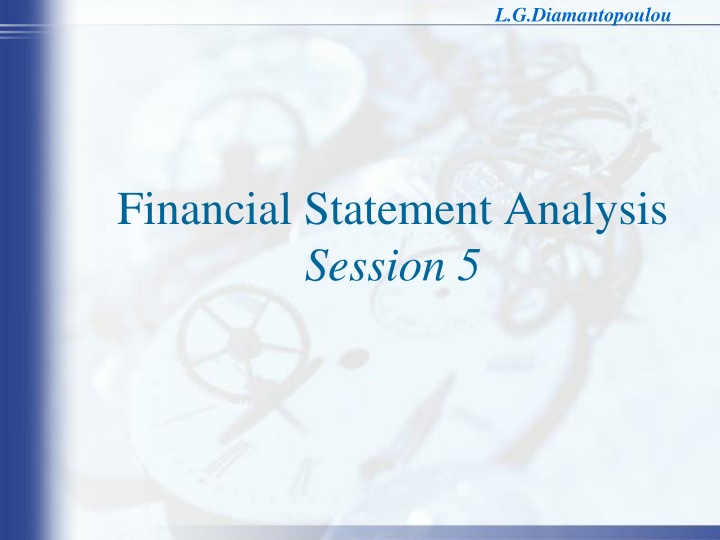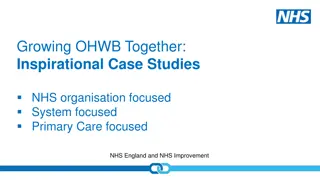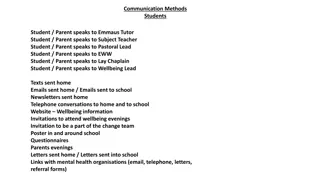Prerequisites for Health and Wellbeing Explained
The essential factors impacting individual and community health, diving into the prerequisites outlined by the Ottawa Charter: Peace, Shelter, Education, Food, Income, Stable Ecosystems, Sustainable Resources, Social Justice, and Equity. Discover how these factors interconnect and influence overall wellbeing.
Download Presentation

Please find below an Image/Link to download the presentation.
The content on the website is provided AS IS for your information and personal use only. It may not be sold, licensed, or shared on other websites without obtaining consent from the author.If you encounter any issues during the download, it is possible that the publisher has removed the file from their server.
You are allowed to download the files provided on this website for personal or commercial use, subject to the condition that they are used lawfully. All files are the property of their respective owners.
The content on the website is provided AS IS for your information and personal use only. It may not be sold, licensed, or shared on other websites without obtaining consent from the author.
E N D
Presentation Transcript
L.G.Diamantopoulou Financial Statement Analysis Session 5
Bankruptcy risk Empirical studies of bankruptcy attempt to distinguish the financial characteristics of firms that file for bankruptcy from those that do not, a dichotomous outcome. The objective is to develop a model that predicts which firms will likely file for bankruptcy one or more years before the filing. These models use financial statement ratios and other data. 2
Bankruptcy risk Multiple Discriminate Analysis (Z-scoring) Perhaps the best-known MDA bankruptcy prediction model is Altman s Z-score (1968). He used data for manufacturing firms to develop the model. In applying this model, Altman found that Z-scores of less than 1.81 indicated a high probability of bankruptcy, while Z-scores higher than 3.00 indicated a low probability of bankruptcy. Scores between 1.81 and 3.00 were in the gray area. Working Capital Total Assets Retained Earnings Total Assets Z-score=1.2 +1.4 Earnings Before Interest and Taxes Total Assets +3.3 Market Value of Equity Book Value of Liabilities +0.6 Sales +1.0 Total Assets 3
Bankruptcy risk Multiple Discriminate Analysis (Z-scoring) Each ratio captures a different dimension of profitability or risk as follows: 1. Net Working Capital/Total Assets: The proportion of total assets comprising relatively liquid net current assets (current assets minus current liabilities). This ratio serves as a measure of short-term liquidity risk. 2. Retained Earnings/Total Assets: Accumulated profitability and relative age of a firm. 3. Earnings before Interest and Taxes/Total Assets: A variant of ROA. This ratio measures current profitability. 4. Market Value of Equity/Book Value of Liabilities: A form of the debt-to-equity ratio but it incorporates the market s assessment of the value of the firm sshareholders equity. Therefore, this ratio measures long-term solvency risk and the market s overall assessment of the profitability and risk of the firm. 5. Sales/Total Assets: Similar to the total assets turnover ratio. This ratio indicates the ability of a firm to use assets to generate sales. 4
Bankruptcy risk Logit Scoring Model Original Ohlson Model (1980): Total Liabilities Total Assets y = -1.32 - 0.407 Size + 6.03 Working Capital Total Assets Current Liabilities Current Assets -1.43 + 0.0757 Net Income Total Assets Working Cap ital Flow from Operations Total Liabilities -2.37 - 1.83 One if net income was negative for the last two years Zero if net income was not negative for the last two years +0.285 One if total liab Zero if total liabilities do not exceed total assets ilities exceed total assets -1.72 1 = Probabilit y of Bankruptcy + 1 e - y Change in Net Income -0.521 approximat is e where ely 2.718282 Sum of absolute values of current and prior years' net incomes 5
Fundamental strength/weakness Piotroski (2000): FSCORE measures the fundamental strength (or weakness) of a firm and is constructed following the methodology of Piotroski (2000). The aggregated statistic, FSCORE, is based on the sum of nine binary indicator variables that capture different aspects of the firm s financial strength (or weakness). If an underlying condition is true, its indicator variable takes the value of one, otherwise it takes zero. Since the underlying conditions are signals for future profitability and cash flows, an indicator variable of one awards a firm s improvement whereas an indicator variable of zero stands for a firm s deterioration and no points are awarded. Its nine underlying financial ratios are designed to measure three different dimensions of a firm s financial condition: profitability, change in financial leverage/liquidity, and change in operational efficiency. Namely, the nine conditions are: 6
Fundamental strength/weakness Profitability signals: 1) Return on assets (ROA) is positive. This condition screens out loss making companies. ROA is measured as net income scaled by lagged total assets. 2) The value of cash flow from operations (CFO) is positive. This condition filters out companies whose core business activities are not thriving. CFO is measured as cash flow from operations scaled by lagged total assets. 3) Change in return on assets ( ROA) is positive. This condition eliminates businesses where asset growth outpaces profit growth, in a sense that ROA s decline signals companies decreasing ability to find and capture attractive opportunities relative to their asset base. ROAis measured as the annual change in return on assets. 4) The value of accruals (ACCRUAL) is negative: This condition attempts to screen out companies that may be engaging in profit manipulation. ACCRUAL is measured as net income less cash flow from operations, scaled by average total assets. 7
Fundamental strength/weakness Signals of change in financial leverage/liquidity: 5) Change in leverage ( LEVER) is negative: This condition intends to filter out companies of increasing financial leverage because of their shortfalls in free cash flows and possible additional constraints on overall financial flexibility. LEVER is measured as the change in the ratio of long-term debt to total assets. 6) Change in liquidity ( LIQUID) is positive: This condition attempts to screen out companies unable to service current debt and working capital obligations, firms facing liquidity difficulties. LIQUID is measured as the annual change in the current ratio (CR). CR is the ratio of current assets 7) The firm did not issue common equity (ISSUANCE): Similar to the increasing financial leverage, this condition filters out companies unable to raise enough internal funds to meet potential obligations. 8
Fundamental strength/weakness Signals of change in operational efficiency: 8) Change in gross margin ratio ( MARGIN) is positive: This condition eliminates businesses with increasing factor and inventory costs, falling selling prices of the firm s product, or an unprofitable change in product mix toward less profitable lines, geographic regions, and/or customers. MARGIN is measured as the annual change in gross margin ratio (MARGIN). MARGIN is the difference between sales and cost of goods sold, divided by sales. 9) Change in asset turnover ( TURN) is positive: This condition intends to filter out companies that have declining asset efficiency. TURN is measured as the annual change in asset turnover ratio (ATR). ATR is the ratio of sales to total assets. Formally, it is expressed as follows ?????? = ROA+CFO+ ROA+ACCRUAL+ LEVER+ LIQUID+ISSUANCE+ MARGIN+ TURN An FSCORE between 5 and 9 indicates strong fundamentals, whereas an FSCORE between 0 and 4 indicates weak fundamentals. 9
Financial Reporting Manipulation Risk All models use accounting data Barton and Simko (2002) argue that the balance sheet records all past accounting choices, so the level of assets can then reflect past earnings management. Thus, assessing financial reporting manipulation risk is an integral part of using financial statement data as the basis of risk analysis. Enron, Parmalat, WorldCom, Global Crossing, Ahold, Sunbeam, AIG, Fannie Mae, Tyco, Societe General, Allied Irish, Satyam, and other companies have been the subject of SEC and other government regulatory investigations and negative media coverage in recent years for allegedly preparing financial statements outside the limits of permissible accounting standards. Earnings manipulation, which refers to reporting amounts outside the limits of U.S. GAAP or IFRS, is the subject of this section. Earnings management refers to choices made within the limits of U.S. GAAP or IFRS or may refer to actual operating decisions that affect reported earnings. 10
Financial Reporting Manipulation Risk Motivations for Earnings Manipulation 1. To influence stock prices positively (or delay stock price declines) by meeting or beating the market s expectations for earnings 2. To increase management bonuses based on earnings or stock prices 3. To obtain debt financing at a lower cost by appearing more profitable or less risky 4. To avoid violation of debt covenants or influence the effects of other binding constraints from accounting-based contracts 5. To influence the outcomes of transactions that affect corporate control, such as proxy fights, takeovers, initial public offerings, seasoned equity offerings, and share repurchases 6. To avoid regulatory intervention or adverse political consequences 11
Financial Reporting Manipulation Risk Manipulation of financial statements always involves doing one of two things either manipulating records to inflate apparent revenue or manipulating them to reduce apparent expenses or liabilities. How? Recording revenue prior to supplying goods or services Reporting income from investments or capital obtained by taking out a loan as business revenue Capitalizing ordinary business expenses, thus shifting them from the income statement to the balance sheet Inaccurately reporting liabilities or altogether neglecting to report them at all 12
Financial Reporting Manipulation Risk Earnings management techniques i. Cookie jar reserve technique: The cookie-jar technique deals with estimations of future events. According to GAAP, management has to estimate and record obligations that will be paid in the future as a result of events or transactions in the current fiscal year based on accrual basis. Under the cookie-jar technique, the corporation will try to overestimate expenses during the current period to manage earnings. If and when actual expenses turn out lower than estimates, the difference can be put into the "cookie jar" to be used later when the company needs a boost in earnings to meet predictions. Some examples of estimation to manage earnings are: sales returns and allowances, estimates of bad debt and write-downs; estimating inventory write downs; estimating percentage of completion for long term contracts etc 13
Financial Reporting Manipulation Risk ii. Big Bath Techniques: Although a rare occurrence, sometimes corporations may restructure debt, write-down assets or change and even close down an operating segment. In these instances, expenses are generally unavoidable. If the management record estimated charge (a loss) against earnings for the cost of implementing the change then it will negatively affect the cost of the share price. But the share price may go up rapidly if the charge for restructuring and related operational changes is viewed as positively. According to Big bath technique, if the manager have to report bad news i.e., a loss from substantial restructuring , it is better to report it all at once and get it out of the way. 14
Financial Reporting Manipulation Risk iii. Flushing the investment portfolio: To achieve strategic alliance and invest their excess funds, a company buys the shares of another company. Actual gains or losses from sales or any changes in the market value of trading securities are reported as operating income where as any change in market value of available for sale securities during a fiscal period is reported other comprehensive income. A manager can manage its earnings through various techniques which are: i. timing sales of securities that have gained value: The company can sell a portfolio security that has an unrealized gain and can report the gain as operating earnings if it is required ii. Timing sales of securities that have lost value: If the manager wants to show lower earnings then he can sell the security that has an unrealized loss and report the loss in operating earnings. iii. Change of holding intent, write-down impaired securities: Management can manage earnings through change of its holdings from available to sale securities to trading securities and vice versa. This would have the effect of moving any unrealized gain or loss on the security to or from the income statement 15
Financial Reporting Manipulation Risk V. Through out a problem child: To increase the earnings of future period, the company can sell the subsidiary which is not performed well i. e. the problem child subsidiary may be thrown out. Earnings can be managed through sell the subsidiary, exchange the stock in an equity method subsidiary and spin off the subsidiary. A gain or loss is reported in the current period statement when a subsidiary is sold. The existing shareholders become the owner of the problem child by distributing or exchanging the shares of a subsidiary with the current shareholders. As a result, no gain or loss is normally reported on a spin off 16
Financial Reporting Manipulation Risk iV. Big Bet on the future technique: When an acquisition occurs, the corporation acquiring the other is said to have made a big bet on the future. Under Generally Accepted Accounting Principles (GAAP) regulations, an acquisition must be reported as a purchase. This leaves two doors open for earnings management. In the first instance, a company can write off continuing R&D costs against current earnings in the acquisition year, protecting future earnings from these charges. This means that when the costs are actually incurred in the future, they will not have to be reported and thus future earnings will receive a boost. The second method is to claim the earnings of the recently acquired corporation. When the acquired corporation consolidated with parent company earnings, then immediately receive a boost in the current year s earnings. By acquiring another company, the parent company buys a guaranteed boost in current or future earnings through big bet technique. 17
Financial Reporting Manipulation Risk V. Introducing new standard New rules and regulations are introduced in GAAP due to changing demand of business environment. Accounting principles can be modified in a way that will not change the earnings. When a new accounting standard is adopted it takes two to three years to adopt the standard. Voluntary early adoption may provide an opportunity to manage the earnings. A company can take the advantage of manage earnings by changing the time an accrual basis rather than cash basis those are recorded as expense on a cash basis. Moreover, timely adoption of a better revenue recognition rule will provide anew window to manage the earnings. 18
Financial Reporting Manipulation Risk Vi. Operating versus non operating Income: Earnings are two types: operating and non-operating. Non operating earnings will not affect future earnings where as operating earnings are expected to continue in the near future. Nonoperating income includes: discontinued operations, extraordinary gains or losses, cumulative effect of change in accounting principles. The manager can manage its earnings when making decisions about reported as assets and liabilities in the balance sheet and measured at fair value. Gains and losses from derivate transactions are generally recognized immediately in regular income. For example, suppose a company had a large issue of bonds outstanding at a fixed interest rate. The company could enter into an interest rate swap that would effectively convert the fixed rate bonds into variable rate bonds. When the interest rate increases, the company would then record an increase in interest expense for the bonds and a decrease if the rate has decreased. Since, when the company enters into the swap is up to the company, the timing option provides an opportunity to manage the earnings 19
Financial Reporting Manipulation Risk Vii. Shrink the ship: Companies do not have to report any gain or loss for repurchase of their own shares on the income statement because no income is recognized on the transaction. Income is only earned through equity transactions outside the firm, not with those involving the firm s owners. A stock buy does not affect earnings but it is used to affect earnings per share. So, these are the common & popular earnings management techniques. Management uses these techniques as & when required to manage earnings. Management uses cookie jar reserve technique to show boom earnings in the future period. Big Bath technique are used in the belief that if a manager have to report bad news i.e., a loss from substantial restructuring , it is better to report it all at once and get it out of the way. Sometimes a subsidiary may underperformed & the earnings of this type of security are managed by throw out a problem child method. Companies that changes GAAP have to take care that stock market does not view the change as lowering the quality of earnings. Timely disposition of long term productive assets (Sale/leaseback and asset exchange technique) can result in the recording of unrealized gains or losses. Under the amortization, depreciation and depletion method, management manages earnings by selecting the write off method & period & estimating salvage value 20
Models used to detect earnings management Jones (1991) proposes a model that attempts to control the effects of changes in a firm s economic circumstances on non-discretionary accruals. This model indicates that changes in total assets, gross revenue, and gross property plant and equipment (PPE) are the determinants of non-discretionary accruals. The idea of the Jones (1991) model is that sales revenue proxies for the economic events that generate current non-discretionary accruals, while gross PPE controls for non-discretionary accruals related to depreciation expense. Thus the Jones (1991) model is based on two key assumptions. Firstly, sales revenue is assumed to be unmanaged. Secondly, changes in current assets and liabilities are assumed to be driven by changes in sales revenue. The specific features of the Jones model (1991) include: 1. abandoning the assumption that non-discretionary accruals are constant over time and 2. attempt to control the effects of changes in operating performance of the company over the measurement of non-discretionary accruals. The limitation of the model is that it ignores the potential managerial manipulation of revenues (Jones, 1991). 21
Models used to detect earnings management 22
Models used to detect earnings management 23
Models used to detect earnings management 24
Models used to detect earnings management 25
Models used to detect earnings management 26
Models used to detect earnings management 27
Models used to detect earnings management 28
Models used to detect earnings management 29
Models used to detect earnings management 30
Models used to detect earnings management Beneish (1999) proposesa mathematical model that uses financial ratios and eight variables to identify whether a company has manipulated its earnings. It is used as a tool to uncover financial fraud. The basic theory that Beneish bases the ratio upon is that companies may be more likely to manipulate their profits if they show deteriorating gross margins, operating expenses and leverage both rising, along with significant sales growth. These factors may cause profit manipulation through various means. The Beneish model's eight variables are: 1. DSRI: Days' sales in a receivable index 2. GMI: Gross margin index 3. AQI: Asset quality index 4. SGI: Sales growth index 5. DEPI: Depreciation index 6. SGAI: Sales and general and administrative expenses index 7. LVGI: Leverage index 8. TATA: Total accruals to total assets 31
Models used to detect earnings management The formula to calculate the M-score is: M-score = 4.84 + 0.92 DSRI + 0.528 GMI + 0.404 AQI + 0.892 SGI + 0.115 DEPI 0.172 SGAI + 4.679 TATA 0.327 LVGI The threshold value is -1.78 for the model whose coefficients are reported above. (see Beneish 1999, Beneish, Lee, and Nichols 2013, and Beneish and Vorst 2020). If M-score is less than -1.78, the company is unlikely to be a manipulator. For example, an M-score value of -2.50 suggests a low likelihood of manipulation. If M-score is greater than 1.78, the company is likely to be a manipulator. For example, an M-score value of -1.50 suggests a high likelihood of manipulation. 32
Just Remember . . . scoring systems superior . . 33























